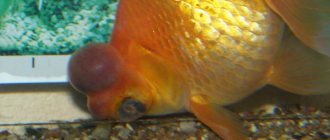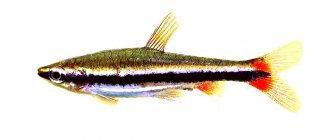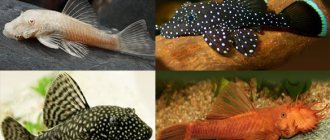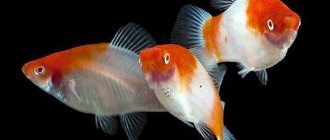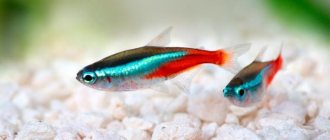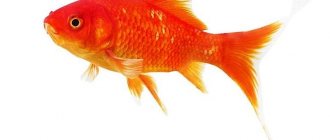The swordtail is a well-known and popular fish. The fame and popularity of swordtails can be compared, perhaps, only with guppy fish, and if you make a ranking of the popularity of aquarium fish, then the swordtail fish will most likely be in second place after guppies.
I have already mentioned earlier that the fame and popularity of aquarium fish is directly related to their ease of keeping and breeding; after all, you can’t compare, for example, handsome discus fish with swordtails or guppies, but in the popularity ranking the guppy takes the palm because discus fish are easier to keep than guppies. breeding is not at all easy. So why are guppies more popular than swordtails? Yes, because swordtails are somewhat inferior to guppy fish in keeping and breeding.
Swordtail fish are more demanding in terms of keeping conditions and are more susceptible to diseases, and the fry of guppies can grow in thickets of plants on their own and even in a general aquarium, but swordtail fry need to be kept in a separate aquarium and fed with better quality food.
But just like guppies, swordtail fish are quite simple to keep and breed; they are popular and are often found in the aquariums of both beginners and experienced aquarists.
Description
Dear readers! First of all, I would like to present to your attention material from Wikipedia where, in my opinion, it is necessary to make small but very important amendments.
The (green) swordtail (Geller's swordtail, lat. Xiphophorus hellerii) is a species of viviparous ray-finned fish of the poeciliaceae family.
The green swordtail (Xiphophorus helleri) lives in the wild, which under artificial conditions easily crosses with another species of the same genus - the common platie (Xiphophorus maculatus). The resulting hybrid forms: black, red, lemon, red-speckled are also called swordtails.
When the aquarium is overpopulated with females, swordtails change sex. Females grow a conical “sword” of the caudal fin and a genital organ. The offspring of a female + former female pair consists of almost 80-90% females.
Note: I have observed sex changes in swordtails several times. I cannot say that females change sex due to the small number of males, since according to my observations, sex change always occurred when there were a sufficient number of males. I also want to note that the males obtained from females are larger than ordinary males: they are passive, clumsy, and do not fertilize females and leave no offspring.
Wild forms: body length of males is up to 8 cm, females - up to 12 cm. In males, the lower part of the caudal fin forms a peculiar outgrowth - a sword (hence the name); coloring: on a grayish-olive background there is a longitudinal red stripe and several more reddish stripes in parallel. Females are paler. The male has a gonopodium - an anal fin transformed into a sexual organ.
Hybrid forms: can be black, red, lemon, and other colors. Males and females are not very different; they are the same in color. The male can be distinguished by the sword at the bottom of the tail and the gonopodium.
Representatives of the genus Xiphophorus inhabit the water bodies of Central America, mainly in the areas of Mexico, Guatemala, and Honduras adjacent to the Atlantic coast. They are found both in mountain rivers with rapid currents and in their lower reaches, as well as in lakes, swamps, and lagoons.
Conditions of detention:
Water temperature: 22-26 °C. Tolerates temperatures down to 15 °C well.
Water hardness: 8–25 °dH
Water acidity: pH 7-8
Note: a water temperature of 22° degrees for keeping swordtails is considered unacceptably low and will cause ichthyophthyriasis in them, and a decrease to 15° will completely kill the fish.
Food: live (tubifex, bloodworms, coretra, daphnia, cyclops), flakes, canned. It tolerates long intervals between feedings, especially if there are live plants in the aquarium, as it can feed on various algae that grow on the leaves of higher plants and the walls of the aquarium.
Note: algal fouling is another source of food for fish of the poeciliaceae family. If necessary, fish: Swordtails, Guppies and Mollies can feed on fouling of brown and green algae, thereby compensating for the lack of food or plant food.
Differences between females and males
Usually, only experienced breeders can distinguish a female from a male. But swordtails are that rare case when the sex is quite easy to distinguish by external signs.
Male sexual characteristics:
- there is a xiphoid process on the fin;
- the anal fin-gonopodium is pointed and narrow, while the female’s is wide (this is necessary for fertilization);
- smaller body sizes.
There have been cases when a female changed her sex: she grew a sword-shaped fin and cared for females. However, after rebirth, the fish became sterile. The reasons for such phenomena have not yet been established.
Capacity and shape of the aquarium
It is possible to keep swordtails in a small aquarium (from 30 liters), be sure to take into account the number of fish based on the recommended standards, where there should be 1 liter per 1 cm of fish length. water. To create and maintain a complete habitat in an aquarium, the presence of soil, plants, as well as aeration and water filtration are required.
When choosing the capacity and shape of an aquarium, you need to know that male swordtails are not friendly towards each other and, given this, it is advisable to choose an aquarium that is more spacious and elongated.
Care requirements and conditions for keeping swordtails
Swordtails do not need any special conditions. In fact, maintaining optimal aquarium water parameters is the key to their well-being. However, do not forget that:
1. Swordtails definitely need aeration and filtration, weekly replacement of up to 1/4 of the volume of aquarium water. It is worth noting that these fish do not need a lot of oxygen, and too frequent changes (replacement) of aquarium water are not as beneficial for them as for other types of aquarium fish. Therefore, if you change the water less often, for example, once every 14 days, and not every 7, nothing bad will happen. This rule is appropriate with a stable biobalance and zero nitrogen: NH4, NO2, NO3.
Red swordtail photo
As with any other fish, high concentrations of poisons are unacceptable: ammonia, nitrites and nitrates . Every conscientious aquarist should always have a set of drop tests on hand, at least for nitrate and phosphate. Fortunately, they have now become inexpensive, there are no problems with their assortment and acquisition. For example, we can with a clear conscience recommend you the cool UHE drop tests, , but they are sold only online. In stores in your city - offline, you can find inexpensive Vladox tests . Friends, watch out for nitrogen compounds, keep them in check and everything will be fine for you and your pets.
It would be useful to use clean water supply for deep water changes and use preparations that neutralize harmful substances. For example, Tetra AquaSafe - it removes chlorine compounds, heavy metals + contains B vitamins, iodine and other aquarium goodies.
Red swordtail photo
2. The aquarium must be covered with a lid, because The fish are nimble and can jump out and die.
3. Like many fish, swordtails feel comfortable among vegetation. Vallisneria , Echinodorus , Cryptocoryne , Riccia , duckweed as aquarium plants for them . Creating thickets of plants imitates the natural habitat of fish.
4. When decorating an aquarium, it is necessary to organize an open space for swimming. Swordtails are excellent swimmers. Swordtails do not need shelter at all.
Water temperature
Swordtail fish are very sensitive to temperature changes and a sharp shift in temperature downward can cause the disease ichthyophthyriosis in fish. The initial sign of the disease is compression of the fins and scratching of the fish on the ground. For the comfortable health of fish, it is advisable to maintain the lower temperature limit at 26°C. To avoid temperature changes, and especially in autumn and spring, when central heating is turned off in the aquarium, it is necessary to install a heater with a built-in thermostat in the aquarium.
Feeding
Proper feeding of swordtails is not only health, but also the key to success in their breeding. Adult swordtails raised on live food are characterized by good health. Such fish do not get sick; they are always cheerful and active. Fish raised on live food can feed on various foods of artificial origin for a long time, as well as dry food: gammarus, daphnia food.
I feed my fish minced beef heart or just a scraper from a knife. But keeping fish for a long time without live food can lead to their exhaustion. Therefore, to maintain health, they need to be fed with a live lump at least occasionally. The following are very suitable live food for swordtail fish: small bloodworms, coretra, tubifex and daphnia.
It is not always possible to obtain such food, so many experienced aquarists breed live food on their own. I feed my fish with Daphnia moina. I breed Daphnia at home. Fish really like Daphnia, and they eat it willingly.
What to feed?
Unpretentiousness in food is another advantage of these fish. But in order for their growth and development to be optimal, the diet should be varied and alternated. What can I use?
- Dry, live and frozen food (bloodworms, brine shrimp, daphnia, etc.).
- Plant foods prepared independently (seaweed, spinach, nettles, lettuce are scalded with boiling water and then chopped).
- Non-standard feeding: boiled egg yolk, crackers, squid or boiled fish. Of course, everything needs to be crushed first.
Swordtails are not only omnivores, but also prone to overeating, so fasting days and even a week-long hunger strike will not harm them.
Remains of food must be removed so that the water in the aquarium remains clean longer.
Herbal supplements
As a herbal supplement, you can feed swordtails: white bread crumb and semolina. It’s not at all difficult to prepare such a simple additive: just rinse the bread crumb well in a net under the tap and only then feed it to the fish. Semolina must be steamed first.
This is done like this: pour half a teaspoon of semolina into a glass, mug, etc., then pour boiling water over it, stirring, and let stand for 15-20 minutes. Then you need to drain the cloudy water and add fresh water. Repeat the procedure until the water becomes completely clear.
Diseases
Most aquarium fish diseases are caused by improper maintenance. Frozen swordtails that have never seen live food tend to be stunted. Their behavior is sluggish; they become more and more secluded; they rarely swim to the feeder and eat poorly. The most common disease among swordtails is ichthyophthyriosis.
The causative agent of the disease is a ciliate that parasitizes the body of fish, but it usually affects only fish with a weakened immune system. The first signs of the disease: compression of the fins and scratching of the fish on the ground, as well as the appearance of a white coating in the form of white dots (semolina) on the body and fins. Sick fish completely refuse food, quickly become exhausted and eventually die.
Swordtail fish - species
In fact, Swordtails can be divided into two types - natural and aquarium.
The aquarium species has many varieties bred by breeders. The names of those bred by selection are associated, first of all, with the peculiarities of coloration, size and shape of the fins.
The natural species of Swordtails is classified by experts more definitely and has about a dozen varieties. All of them have a predominant greenish color and, as a rule, are not kept in home aquariums.
Treatment
Treatment is carried out using salt baths, as well as medications. Treatment can be carried out both in a general and separate aquarium. The first option can only be used if all the fish in the aquarium are infected. Its disadvantage is that the use of drugs such as rivanol, bicillin, etc. can destroy delicate plant species.
The second option, where treatment is carried out in a separate aquarium, is more preferable. As a rule, separate aquariums for quarantine and treatment of fish have a relatively small capacity and, if necessary, you can easily and quickly change the water in them. According to my observations, treating fish using salt baths is ineffective.
But with treatment using the drug bicillin 5, I really managed to save a lot of fish.
Treatment is carried out as follows: the drug bicillin 5 is dissolved in warm water and added in the following ratios: in a general aquarium, 500,000 units per 100 liters, six times, every other day. In a separate vessel, 1,500,000 units per 10 liters, 30 minutes, six times, every other day. The water temperature during treatment should be raised to 27-28° C.
Also, during treatment, it is necessary to monitor the fish and, if they begin to experience discomfort, which most likely indicates an overdose, it is necessary to urgently replace part of the water with fresh water, otherwise the fish will die. Read more about diseases and treatment of fish in the section: “Diseases of aquarium fish.”
Content
Keeping swordtails in aquariums is quite easy because of their unpretentiousness to the composition and volume of water. There should be at least 6 liters of water per couple. The aquarium needs to be long, with a lid (they can jump out of the water).
Optimal water parameters : temperature 22-24°C, dH 5-20°, pH 7.0-8.0. Requires strong aeration and filtration. Once a week it is necessary to replace the water by 1/3 of the volume. It is recommended to add sea or table salt to the water: 1 tbsp. for 10 liters of water.
Dense thickets of small-leaved plants (for example, serrated elodea, cabomba, vallisneria) are perfect for an aquarium with swordtails. But there must also be free space for fish to swim. You can float Riccia on the surface of the water.
Any peaceful fish will be suitable as neighbors. In a group, there are conflicts between swordtail males, so it is necessary that there are more females than males. In this case, there should be either one male or more than three individuals - aggression is dispersed, and not directed directly at each other between two males.
Water parameters
The most suitable water temperature for keeping representatives of the species is 22-26°C, however, fish can tolerate a short decrease to 15°C without harm to health. The acidity of the water should be within 7-8, hardness – 6-25°. Water should not contain nitrogen compounds (NH4, NO2, NO3). If they are detected, part of the volume should be replaced with clean water.
Aquarium
It is recommended to keep aquarium swordtail fish in a school, with at least 2-3 females for each male. Otherwise, males regularly get into fights, during which they inflict serious injuries on each other. Such a group of fish will require a large aquarium. The smallest possible tank volume is 50 liters, but for greater comfort it is advisable to keep a flock of at least 100 liters. The shape of the container is preferably rectangular and horizontally oriented, because These fish are quite large and need space to swim.
This species uses the entire volume of the aquarium for swimming, but spends most of its time in the upper part of the reservoir, moving almost close to the surface of the water surface. The fish are extremely active, and males often jump out of the water, chasing each other or females. Due to this feature, the aquarium for swordtails should always be closed with a lid.
Duckweed, riccia and similar plants floating on the surface will also help prevent jumping out. Other suitable plants are Cryptocoryne, Vallisneria, Echinodorus. Creating dense thickets makes the pond resemble the natural habitat of the fish and reduces the likelihood of conflicts between males.
When designing an aquarium, you should give the fish enough space to swim. This species is not shy, so shelter in a pond is not required. Medium or fine-grained soil is placed at the bottom. It is not recommended to use coarse-grained substrate, because It will be difficult for fish to get food that has fallen between its particles.
The aquarium must be equipped with a filter and an aeration system. This species, like other poeciliids, is quite resistant to a lack of oxygen, therefore, in the absence of overpopulation and if there are a large number of plants in the reservoir, additional aeration may not be installed. However, to prevent stagnation and uneven heating of water, as well as to ensure a more comfortable life for the fish, it is advisable to place a sprayer in the aquarium; the compressor may not be very powerful. Aeration is especially necessary in summer, when the amount of oxygen dissolved in it decreases due to heating of the water.
On a note! To maintain the water temperature at a given level, a heater is placed in an artificial reservoir. The indicator is monitored using a thermometer attached to the wall of the container.
Water changes should be made once every 7-10 days, replacing no more than 1/3 of the volume at a time. The species does not tolerate frequent changes and abrupt changes of large volumes of water at a time. When biological balance is established and there are no nitrogenous compounds in the water, changes can be made even less frequently. The need for the procedure is determined using tests showing water parameters.
Plants
In nature, these fish settle in dense thickets of vegetation, which serve them as food and protection from enemies, so the aquarium should also have a lot of algae. Usually the following is placed in the container:
- Vallisneria;
- Echidonorus;
- cryptocorynes.
In this case, islands of plants should be combined with wide space for swimming.
Otsadnik
If you use a dark trap for childbirth, in this case you need to open it for a while every day to feed the female, and if necessary, change the water. Eventually one day you will open the hatchery and see a bunch of fry in there. Hurry to return the female to the general aquarium, and carefully transfer the fry to the nursery aquarium.
Previously, I used an ordinary three-liter jar as a depositor. He did it this way: he filled the jar with water from the same aquarium where the pregnant female was located, then he caught the female, put it in the jar and covered it with a jacket or a black plastic bag in order to create darkness in the jar so that the female would not see and eat the fry.
The disadvantage of such a fish tank is that after birth it is difficult to catch the female and fry from the jar and you have to carefully pour the contents of the jar into a basin so as not to injure the fry, and then start catching. It is much easier and more convenient to use a plastic tank with a lid.
After giving birth, you can catch the female with a net and then carefully catch the fry, for example, with a spoon or carefully pour them into a nursery aquarium.
Number of fry
The number of fry among swordtails varies. For example, I once had swordtails that brought more than a hundred fry. To date, only two females have given birth in my aquarium, and each produces just over thirty fry.
The color variation of the fry born is different and from red parents the following are born: green, lemon and red fry.
Food for fry
Starter food for fry is like milk for babies, and this food should be the healthiest and most nutritious. The ideal starter food consists of living organisms: ciliates, rotifers, cyclops and daphnia. And the general understanding of the entire listed composition is referred to as “living dust.”
There is no need to look for all the listed feed compositions for your fry. Suitable starter food for swordtail fry are: nematode worms, or even better, daphnia moina. Both types of food are easy to raise at home, and fry of fish from the poeciliaceae family grow very quickly on them.
Reproduction of swordtails
When obtaining offspring of swordtails, it is necessary to achieve the preservation or improvement of the species qualities of the fish. Therefore, it is necessary to decide on a couple that will produce ideal offspring. The first condition is the absence of developmental defects and the health of future producers.
To stimulate the mating games of swordtails, it is necessary to satisfy their requirements for the habitat. This is important for breeding purebred fish at home. There is no need to strive to recreate optimal natural conditions in an aquarium, because humans have domesticated this species for a very long time, which has led to a change in the requirements for living conditions.
Swordtails are viviparous fish. Live fry are born, ready for a full life. Even an ordinary three-liter jar is suitable for producing offspring, but to raise and maintain the fry you need an aquarium of at least 20 liters.
Beginning aquarists should know how long swordtails live at home. Their life cycle lasts from 3 to 6 years while creating quality living conditions. Sexual maturity occurs after 3-5 months, depending on the conditions created by the owner. First of all, you need to adhere to the temperature regime. To ensure the survival of the fry, it is better to use a separate maternity aquarium or a special aquarium, which is installed inside the main aquarium. If you arrange for swordtails to breed in a common aquarium, then the babies can be gobbled up by other inhabitants.
Signs of pregnancy
Typically, females reach full maturity by 8 months, but there are exceptions. By this time, you need to create all the necessary conditions for spawning and start breeding. The fertilization process in swordtails lasts differently. It depends on how many times the female has already mated. If this is her first time, the maximum period is 2 days. Pregnancy lasts from 4 to 6 weeks.
What determines the exact gestation period:
- Diet quality and feeding frequency.
- Temperature indicators of water in the aquarium.
- Lighting.
The process of fertilization of eggs with the male's milk occurs inside the female. Determining that a fish is pregnant is extremely difficult. Only an experienced specialist can do this. Moreover, the probability of confusing a female bearing fry with a large fish is high.
Signs of a pregnant swordtail and its appearance:
- By the end of the gestation period, the belly of the individual becomes visible and large.
- You can see outlines on the stomach. It is square in shape.
- There is a dark spot in the anal fin area.
Preparing fish and spawning grounds for reproduction
Fish will begin to reproduce in a prepared aquarium when the temperature rises to 28-30°C and the water is changed frequently. It is also important to provide intensive aeration. Clean, warm water with a rich oxygen content are optimal conditions for reproduction. The temperature does not rise immediately, but over the course of a week. Set the pH at 7.0-8.0, water hardness is allowed at 10-12 pH. Water temperature determines the prevailing sex of the fry. At 25°C there will be more females, at higher temperatures - males .
To select beautiful fish, it is important to choose the right producers. It is better to select males that are eight months old, and females that are ten months old can be selected. The size of the female should be large, the abdomen should be rounded (a sign of readiness for reproduction).
It is impossible to determine the sex of a swordtail fish by color. These fish are also capable of changing sex.
The process of fertilization is intrauterine. Babies appear after 4-6 weeks. Depending on the age of the species and conditions in the aquarium, the number of pups can range from 50 to 200. In a pregnant female, the back of the abdomen swells and becomes almost square, and a dark spot appears (these are the fry). Swordtail spawning and birth are stimulated by live food, fresh water and sunlight. If there is no separate aquarium, then for spawning you can take an ordinary three-liter jar. Plant vegetation at the bottom in which the fry will hide from the mother (she can eat the young). If swordtails do not want to reproduce, then the reason may be a lack of vegetation. Use settled water. Be sure to provide good aeration. After giving birth, the mother must be removed from the fry, first into another vessel, to make sure that all the fry have been born.
Birth of fry
You can understand that labor is beginning by the individual’s thrashing around the aquarium. Her stomach becomes square. Most often, swordtails give birth in the morning. The number of fry born at one time can reach up to 200 pieces. Newborn fish should be left in a container with their mother.
Reproduction of swordtails in an aquarium can occur constantly. To do this, the water temperature should not fall below 26 degrees. If the owner cannot place the pregnant female in a separate container or compartment, dense bushes in the aquarium will be required. They are needed so that the woman in labor can hide there at the most crucial moment. Male fry born in an aquarium should not remain there forever. As soon as they reach sexual maturity, they need to be removed.
fry of swordtails
Feeding the young
It is clear how swordtails reproduce, but it is important to properly feed the fry. The period from the first seconds of life to a week of age is the most important in feeding young animals. On these days, it is necessary to leave the light on during the dark and give the young fish plenty of complementary foods with a complete chemical composition, otherwise the fry may grow into weak individuals. Microworms (easy to dilute in grated carrots), crushed oligochaetes, rotifers, and cyclops are suitable as the first food. Live food can be replaced with industrial mixtures. Such concentrates combine all the vitamins and nutrients so necessary for young animals. Also, when breeding aquarium swordtail fish, chicken yolk, regular yogurt, and a special omelet are used for feeding.
You can feed the fish with mild cheese. The product is grated on a fine grater and sent in small portions to the aquarium with the fry. Too much feed can spoil the water.
Powdered milk acts as a highly nutritious protein food. You can cook it yourself. A plate of milk is placed in a water bath and evaporated until a dry residue is obtained. The powder is poorly soluble in water and is accessible to fish.
Chicken yolk as food is first ground, a little water taken from the hatchling is added and poured into the fry.
The yolk is an excellent food for bacteria and it quickly pollutes the water, so this food can only be used in case of force majeure. Young fish will not be able to live for long in rotten water, and changing water in large quantities is stressful for the fish.
You can use yogurt to feed the fry. A little curdled milk is poured into boiling water to curdle the casein. The washed protein lumps are placed in a net and placed in the aquarium, shaking slightly. The advantage of this food is that it does not spoil the water. The food should be stored in the refrigerator, but no more than 3-4 days.
Food for juveniles
Growing fry should be gradually accustomed to artificial feed. In my example, I use daphnia, which I breed at home, to raise fry. I begin to accustom the juveniles to artificial food in the second month by adding artificial additives to the diet, for example, minced beef heart or various dry foods: daphnia, gammarus food.
And I do it this way: before giving the waiting fish their usual food, I first add a small amount of minced beef and after 15-20 minutes I give them the live food they are accustomed to. A complete transition to another food will be indicated by the fish being full, which can be easily determined by eating, as well as by the fish’s full bellies.
Transfer to a community aquarium
Young fish that have grown well and are accustomed to artificial food should be transplanted into a community aquarium. The approximate size of such fish can be 2-2.5 cm, and the laggards need to remain in the nursery aquarium to grow up. But in the end, everything will depend on what kind of neighbors await them in the common aquarium.
For example, if they turn out to be large angelfish, golden or Sumatran barbs, do not rush so as not to be eaten by stupid teenagers. Never introduce all fish into a common aquarium at once. If a chase starts, you won't have time to return all the fish safe and sound. For the test, you need to launch only 2-3 fish and, if no one offends them, you can launch the rest. Well, that's probably all. I wish you all success in breeding swordtails!
Compatibility with other fish
Swordtails are peaceful fish and get along well with neighbors of their type. You can safely add guppies, mollies, platies, neons and even gourami or angelfish into the same aquarium with them. If you put them with sedentary fish and smaller specimens, the neighbors will suffer. Males love to bite fins and show their dominance and territory. They can also fight among themselves. Therefore, it is important to keep a balance. It is important that there are more females than males. For one male there should be about 2-3 females.
